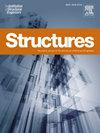Design methodology and seismic performance testing of prefabricated RCS hybrid frame considering composite effects of slabs
IF 3.9
2区 工程技术
Q1 ENGINEERING, CIVIL
引用次数: 0
Abstract
Reinforced concrete column–steel beam (RCS) hybrid frames are an innovative structural system that integrates steel beams and reinforced concrete columns, thereby offering an efficient structural system for modern buildings. However, the influence of the composite effect of the slab on the seismic behaviour has not been fully investigated in current designs. This study introduces a novel prefabricated RCS hybrid frame that explicitly considers slab composite effects and evaluates its seismic performance. A ½–scale one–bay two–storey precast composite column–steel hybrid frame is designed and tested under cyclic loading. The crack propagation, damage progression, failure modes, hysteresis performance, load–bearing capacity, stiffness, deformation, and energy dissipation, among other seismic performance metrics, are analysed. Experimental results indicate that the hybrid frame remains elastic under an overall drift ratio of 0.25 % and achieves an ultimate overall drift ratio of 3.76 %. Additionally, the panel zone remains in an elastic state during loading, with the structure demonstrating favourable plastic deformation and energy dissipation. Results of finite–element analysis indicate that considering the slab composite effects resulted in a 74 % increase in the lateral stiffness and a 44 % increase in the maximum load–bearing capacity. These findings validate the favourable seismic performance of the proposed RCS hybrid frame system and provide valuable scientific and technical insights for optimising such structural designs.
求助全文
约1分钟内获得全文
求助全文
来源期刊

Structures
Engineering-Architecture
CiteScore
5.70
自引率
17.10%
发文量
1187
期刊介绍:
Structures aims to publish internationally-leading research across the full breadth of structural engineering. Papers for Structures are particularly welcome in which high-quality research will benefit from wide readership of academics and practitioners such that not only high citation rates but also tangible industrial-related pathways to impact are achieved.
 求助内容:
求助内容: 应助结果提醒方式:
应助结果提醒方式:


